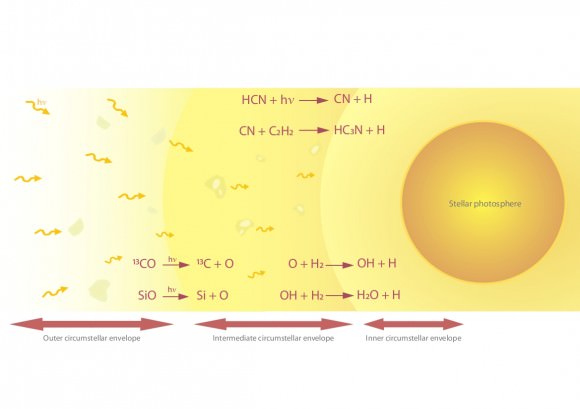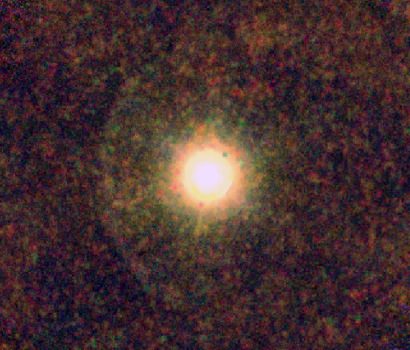[/caption]
There’s something strange going on around the red giant star CW Leonis (a.k.a. IRC+10216). Deep within the star’s carbon-rich veil, astronomers have detected water vapor where no water should be.
CW Leonis is similar in mass to the sun, but much older and much larger. It is the nearest red giant to the sun, and in its death throes it has hidden itself in a sooty, expanding cloud of carbon-rich dust. This shroud makes CW Leonis almost invisible to the naked eye, but at some infrared wavelengths it is the brightest object in the sky.
Water was originally discovered around CW Leonis in 2001 when the Submillimeter Wave Astronomy Satellite (SWAS) found the signature of water in the chilly outer reaches of the star’s dusty envelope at a temperature of only 61 K. This water was assumed to be evidence for vaporizing comets and other icy objects around the expanding star. New observations with the SPIRE and PACS spectrometers on the Herschel Space Observatory reveal that there’s something much more surprising going on.
“Thanks to Herschel’s superb sensitivity and spectral resolution, we were able to identify more than 60 lines of water, corresponding to a whole series of energetic levels of the molecule,” explains Leen Decin from the University of Leuven and leader of the study. The newly-detected spectral lines indicate that the water vapor is not all in the cold outer envelope of the star. Some of it is much closer to the star, where temperatures reach 1000 K.
No icy fragments could exist that close to the star, so Decin and colleagues had to come up with a new explanation for the presence of the hot water vapor. Hydrogen is abundant in the envelope of gas and dust surrounding carbon stars like CW Leonis, but the other building block of water, oxygen, is typically bound up in molecules like carbon monoxide (CO) and silicon monoxide (SiO). Ultraviolet light can split these molecules, releasing their stored oxygen, but red giant stars don’t make much UV light so it has to come from somewhere else.

The dusty envelopes around carbon stars are known to be clumpy, and that turns out to be the key to explaining the mysterious water vapor. The patchy structure of the shroud around CW Leonis lets UV light from interstellar space into the depths of the star’s envelope. “Well within the envelope, UV photons trigger a set of reactions that can produce the observed distribution of water, as well as other, very interesting molecules, such as ammonia (NH3),” says Decin. “This is the only mechanism that explains the full range of the water’s temperature.”
In the coming months, astronomers will test this hypothesis by using Herschel to search for evidence of water near other carbon stars.


So…. we have a previously sunlike star in its red giant phase, with a cloud of water vapor extending from inside to just around the star. I’m wondering… is it at all possible this is the result of the star consuming or at least vaporizing the oceans of a terrestrial planet, during the period that it swelled up to red giant size?
Obviously not as plausible as the scenario they presented, but would be far more fascinating if so.
The original ESA article states:
I am skeptical about that notion; it’s like suggesting that one can get a suntan at night by the UV light from Sirius! What about cosmic ray spallation, or stellar wind from the star in question being the cause? I say that because we already know, from recent news reports, that the Moon has traces of water over its entire surface as a result of protons from the solar wind interacting with silicates in the lunar regolith.
Oh, and one more thing… at the fifth paragraph (after the caption), there’s a double “in” the fourth line. 🙂
A patchy shroud cover, huh? I assume the cover is better closer in, or it would be the star providing the UV.
And as always, the ubiquitous HCN pathway.
As this star ages, it is processing through its internal elemental abundances as it has gradually CREATED heavier elements in its core. Depending on the size of the stellar body, the elemental procession proceeds from Hydrogen to Helium then from Helium to Oxygen, then from Oxygen to Carbon and so on… from Nitrogen to Silicon to Magnesium to Neon to Iron to Sulfur, so it makes sense that the volumes of Carbon seen at this star are related to the volumes of Oxygen as they have been processed at nearly the same time and are in a closely related but separately stratified layering within the gravity well?
@AQUA,
Actually, according to the triple-alpha process, the correct fusion sequence is:
Then, as a side effect of the process, some carbon nuclei can fuse with additional helium to produce a stable isotope of oxygen and release energy:
Stupid website! The HTML/XML codes did not work correctly; I try that again…
According to the triple-alpha process, the correct fusion sequence is:
Then, as a side effect of the process, some carbon nuclei can fuse with additional helium to produce a stable isotope of oxygen and release energy:
Can their detection system distiguish between H2O molecules and HO radicals? I would like to know.